The Ultimate Guide to Building Your Perfect Rolling Workbench for Any Workspace
In today’s fast-paced work environment, the demand for versatile and efficient workspace solutions is at an all-time high. According to a recent study by the Global Workspace Research Institute, over 65% of professionals report that a well-organized workspace significantly enhances productivity and creativity. One key element to achieving this is the rolling workbench, which combines mobility with functionality, allowing users to tailor their workspaces to their specific needs. This adaptability is crucial, especially in industries such as woodworking and automotive repair, where tools and materials need to be seamlessly accessible. Furthermore, a rolling workbench can optimize limited space by serving multiple purposes, reinforcing its importance in modern design.

In this ultimate guide, we’ll explore essential tips and strategies to build your perfect rolling workbench, ensuring that it meets the unique demands of any workspace.
Designing Versatile Rolling Workbench Dimensions for Optimal Workspace Flexibility
When designing a versatile rolling workbench, understanding optimal dimensions is crucial for enhancing workspace flexibility. According to a report by the American Institute of Architects, the average workspace can increase productivity by up to 15% when it accommodates efficient movement and access. A well-constructed rolling workbench can serve various functions, from a mobile tool station to a dedicated crafting area, emphasizing the importance of adjustable heights and adaptable widths.
To achieve this flexibility, a typical rolling workbench should ideally feature a height range of 28 to 42 inches, accommodating both seated and standing tasks. The width can vary, but a depth of 24-30 inches provides ample workspace without overwhelming the area, allowing for easy navigation.
A survey conducted by the National Association of Home Builders indicates that nearly 70% of professional craftsmen prefer workbenches that can be easily repositioned to adapt to different project requirements. By adhering to these dimensions, builders can create a functional and versatile workbench tailored to diverse work environments.
Essential Materials for Constructing a Durable and Functional Rolling Workbench
When constructing a durable and functional rolling workbench, selecting the right materials is crucial for ensuring longevity and efficiency. According to the American Wood Council, using high-quality hardwood for the tabletop can significantly impact durability. Hardwoods like maple or oak not only resist dents and scratches better than softwoods but also offer a stable work surface, which is essential for precision tasks. The thickness of the tabletop should ideally be at least 1.5 inches to provide adequate support and prevent warping over time.
Moreover, the frame and wheels of your workbench are just as important as the tabletop. Steel is recommended for frame materials due to its strength and resistance to deformation under heavy loads. According to the National Association of Manufacturers, a sturdy frame can support approximately 1,000 pounds when properly constructed. For mobility, selecting heavy-duty swivel casters rated for at least 250 pounds each ensures that your workbench can be moved easily without compromising its stability. Combining these materials effectively will result in a reliable rolling workbench tailored to meet the demands of any workspace.
The Ultimate Guide to Building Your Perfect Rolling Workbench for Any Workspace
| Material | Type | Durability | Cost | Recommended Use |
|---|---|---|---|---|
| Plywood | Structural | High | $30 - $100 | Top Surface |
| Steel Frame | Metal | Very High | $100 - $300 | Frame Construction |
| Caster Wheels | Hardware | Medium | $10 - $40 | Mobility |
| Workbench Top | Wood | High | $50 - $200 | Work Surface |
| Drawer Slides | Hardware | Medium | $15 - $50 | Storage Solutions |
Integrating Smart Storage Solutions to Maximize Workbench Efficiency
Creating an efficient rolling workbench involves more than just selecting a sturdy surface; integrating smart storage solutions is paramount for maximizing functionality. According to a report from the National Institute of Occupational Safety and Health (NIOSH), well-organized work environments can increase productivity by up to 25%. By incorporating features such as adjustable shelving, pegboards, and mobile cabinets, users can tailor their workbench to suit specific tasks, thereby streamlining workflows and reducing clutter.

Smart storage solutions not only enhance productivity but also improve safety by ensuring tools and materials are readily accessible and organized. A study by the American Society of Safety Professionals highlights that workplaces with well-defined storage practices can reduce accidents by over 30%. For instance, magnetic tool holders can keep essential tools within arm's reach while freeing up valuable surface space for larger projects. Integrating these features into a rolling workbench design not only maximizes efficiency but also transforms the workspace into a more enjoyable and productive environment.
Choosing the Right Wheel Type for Stability and Mobility in Workplaces
When building a rolling workbench, the selection of the right wheel type is crucial for ensuring both stability and mobility in your workspace. Casters come in various materials, including rubber, polyurethane, and hard plastic, each offering distinct benefits. Rubber wheels tend to provide excellent shock absorption and are gentle on floors, making them ideal for indoor use. On the other hand, polyurethane wheels are known for their durability and resilience against wear, making them suitable for environments where heavy loads are frequently moved.
Another essential factor to consider is the wheel size. Larger wheels roll over obstacles and uneven surfaces with ease, enhancing usability in a workshop environment. For instance, if your workspace involves moving over rough terrain or thresholds, opting for larger, more robust wheels can prevent the bench from getting stuck and reduce the effort needed to maneuver it. Additionally, the locking mechanism of the wheels should not be overlooked; ensuring that your workbench can be securely fixed in place when needed will provide added safety and convenience during use. By thoughtfully considering wheel type and size, you can create a rolling workbench that meets your specific needs while promoting efficiency in your projects.
The Importance of Wheel Types in Rolling Workbenches
Customizing Your Workbench for Specific Trade Applications: A Data-Driven Approach
Customizing your rolling workbench for specific trade applications involves a data-driven approach, enabling professionals to enhance efficiency and adaptability in their workspaces. By utilizing analytics, tradespeople can assess the precise needs of their workspace based on the types of materials and tools they use regularly. This customization process involves selecting the right surface materials, storage solutions, and mobility features that cater to specific tasks, whether for woodworking, metalworking, or other specialized fields.
As the landscape of workspaces evolves, similar principles apply to the rise of technology in trade and finance. For instance, the adoption of AI in trading platforms exemplifies how data-driven strategies can optimize operations, akin to customizing a workbench for individual needs. In a world where precision and efficiency are paramount, leveraging advanced tools—be it in crafting a bespoke rolling workbench or utilizing intelligent trading systems—can significantly enhance productivity and success in diverse applications.

Related Posts
-

The Evolution of Workspaces with the Best Rolling Workbench Solutions
-

How to Choose the Perfect Rolling Workbench for Your Workspace
-

What Makes the Best Rolling Workbench Essential for Every Workshop
-

How to Choose the Perfect Rolling Workbench for Your Workshop Needs
-

How to Choose the Best Rolling Workbench for Your Workshop Needs
-

Top Strategies for Maximizing Efficiency with Work Bench on Wheels
Footer
Resource Center
Contact Us
1901 West Main Street
Washington, MO 63090
Main Directory: 1-800-227-4873
Email: sale@pangcofurniture.com
Affiliations


